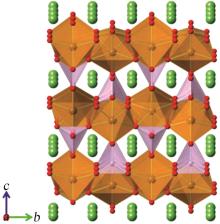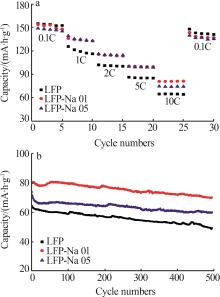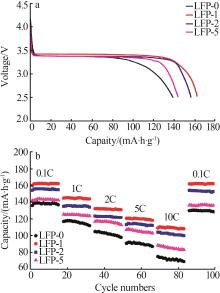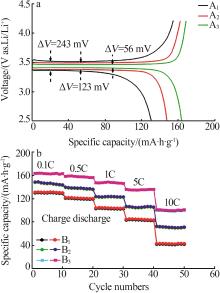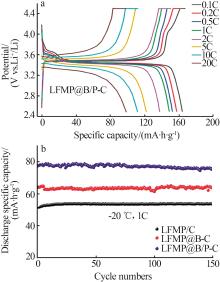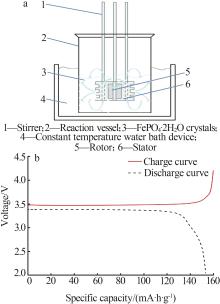Inorganic Chemicals Industry ›› 2023, Vol. 55 ›› Issue (6): 18-26.doi: 10.19964/j.issn.1006-4990.2022-0604
• Reviews and Special Topics • Previous Articles Next Articles
Research progress of modified-LiFePO4 as cathode materials for lithium ion batteries
PAN Xiaoxiao1,2( ), ZHUANG Shuxin1,2(
), ZHUANG Shuxin1,2( ), SUN Yuqing1,2, SUN Gaoxing1,2, REN Yan1,2, JIANG Shengyu1,2
), SUN Yuqing1,2, SUN Gaoxing1,2, REN Yan1,2, JIANG Shengyu1,2
- 1. School of Materials Science and Engineering,Xiamen University of Technology,Xiamen 361024,China
2. Key Laboratory of Functional Materials and Applications of Fujian Province,Xiamen 361024,China
-
Received:2022-10-12Online:2023-06-10Published:2023-06-14
CLC Number:
Cite this article
PAN Xiaoxiao, ZHUANG Shuxin, SUN Yuqing, SUN Gaoxing, REN Yan, JIANG Shengyu. Research progress of modified-LiFePO4 as cathode materials for lithium ion batteries[J]. Inorganic Chemicals Industry, 2023, 55(6): 18-26.
share this article
Table 1
Electrochemical performance of LiFePO4 with different modification strategy"
| 改性策略 | 正极材料 | 锂离子迁移速率/ (cm2·s-1) | 放电容量/ (mA·h·g-1) | 功率密度a(0.1C)/ (W·kg-1) | 能量密度b(0.1C)/ (W·h·kg-1) |
|---|---|---|---|---|---|
| 元素掺杂[ | Li0.98Nb0.02FePO4/C | 2.47×10-14 | 114.3(10C) | 113.28 | 517.75 |
| 元素掺杂[ | LFP-1 | 1.11×10-11 | 110.6(10C) | 117.64 | 501.44 |
| 元素掺杂[ | LFP-VF | 2.94×10-11 | 124.9(10C) | 126.12 | 519.68 |
| 表面碳包覆[ | LFMP@B/P-C | 1.89×10-10 | 97.1(20C) | 115.36 | 502.18 |
| 表面碳包覆[ | LFP@1 | 6.40×10-11 | 119.7(10C) | 120.08 | 527.68 |
| 颗粒纳米化[ | b-LiFePO4/C | 7.35×10-14 | 113(10C) | 106.72 | 527.00 |
| 颗粒纳米化[ | LFP/C | 8.10×10-11 | 140.8(10C) | 134.1 | 544.00 |
| 材料复合化[ | 2LFPLVP-S64 | — | 123(10C) | 129.45 | 531.36 |
| 材料复合化[ | 5LFVP | — | 67(100C) | 102.34 | 413.60 |
| 1 | PADHI A K, NANJUNDASWAMY K S, GOODENOUGH J B.Phospho-olivines as positive-electrode materials for rechargeable lithium batteries[J].Journal of the Electrochemical Society,1997,144(4):1188-1194. |
| 2 | 王甲泰,赵段,马莲花,等.锂离子电池正极材料磷酸铁锂的研究进展[J].无机盐工业,2020,52(4):18-22. |
| WANG Jiatai, ZHAO Duan, MA Lianhua,et al.Research progress of LiFePO4 cathode materials for Li-ion battery[J].Inorganic Chemicals Industry,2020,52(4):18-22. | |
| 3 | 张婷,林森,于建国.磷酸铁锂正极材料的制备及性能强化研究进展[J].无机盐工业,2021,53(6):31-40. |
| ZHANG Ting, LIN Sen, YU Jianguo.Research progress in synthesis and performance enhancement of LiFePO4 cathode materials[J].Inorganic Chemicals Industry,2021,53(6):31-40. | |
| 4 | LI Haoyu, YE Hua, SUN Mingcang,et al.Process for recycle of spent lithium iron phosphate battery via a selective leaching-precipitation method[J].Journal of Central South University,2020,27(11):3239-3248. |
| 5 | YAN Zhixiong, HUANG Dequan, FAN Xiaoping,et al.Fluorine-doped carbon coated LiFePO3.938F0.062 composites as cathode materials for high-performance lithium-ion batteries[J].Frontiers in Materials,2020,6:341. |
| 6 | RISSOULI K, BENKHOUJA K, RAMOS-BARRADO J R,et al.Electrical conductivity in lithium orthophosphates[J].Materials Science and Engineering:B,2003,98(3):185-189. |
| 7 | PROSINI P P, LISI M, ZANE D,et al.Determination of the chemical diffusion coefficient of lithium in LiFePO4 [J].Solid State Ionics,2002,148(1/2):45-51. |
| 8 | ZHANG Baofeng, XU Youlong, WANG Jie,et al.Electrochemical performance of LiFePO4/graphene composites at low temperature affected by preparation technology[J].Electrochimica Acta,2021,368:137575. |
| 9 | LIU Bingqiu, ZHANG Qi, LI Yiqian,et al.Realizing complete solid-solution reaction to achieve temperature independent LiFePO4 for high rate and low temperature Li-ion batteries[J].CCS Chemistry,2022:1-22. |
| 10 | ZHANG Yin, ALARCO J A, NERKAR J Y,et al.Observation of preferential cation doping on the surface of LiFePO4 particles and its effect on properties[J].ACS Applied Energy Materials,2020,3(9):9158-9167. |
| 11 | WANG Hongqiang, LAI Anjie, HUANG Dequan,et al.Y-F co-doping behavior of LiFePO4/C nanocomposites for high-rate lithi-um-ion batteries[J].New Journal of Chemistry,2021,45(12):5695-5703. |
| 12 | LI Lingjun, LI Xinhai, WANG Zhixing,et al.Stable cycle-life properties of Ti-doped LiFePO4 compounds synthesized by co-precipitation and normal temperature reduction method[J].Journal of Physics and Chemistry of Solids,2009,70(1):238-242. |
| 13 | HSIEH C T, CHEN I L, CHEN Weiyu,et al.Synthesis of iron phosphate powders by chemical precipitation route for high-power lithium iron phosphate cathodes[J].Electrochimica Acta,2012,83:202-208. |
| 14 | LIU Yukang, ZHANG Hao, HUANG Zheng,et al.Understanding the influence of nanocarbon conducting modes on the rate performance of LiFePO4 cathodes in lithium-ion batteries[J].Journal of Alloys and Compounds,2022,905:164205. |
| 15 | XI Yuming, LU Yangcheng.Toward uniform in situ carbon coating on nano-LiFePO4 via a solid-state reaction[J].Industrial & Engineering Chemistry Research,2020,59(30):13549-13555. |
| 16 | CHEN C, LIU G B, WANG Y,et al.Preparation and electrochemical properties of LiFePO4/C nanocomposite using FePO4·2H2O nanoparticles by introduction of Fe3(PO4)2·8H2O at low cost[J].Electrochimica Acta,2013,113:464-469. |
| 17 | HUANG Xiaopeng, YAO Yaochun, LIANG Feng,et al.Concentration-controlled morphology of LiFePO4 crystals with an exposed(100) facet and their enhanced performance for use in lithium-ion batteries[J].Journal of Alloys and Compounds,2018,743:763-772. |
| 18 | ZHANG Jiafeng, SHEN Chao, ZHANG Bao,et al.Synthesis and performances of 2LiFePO4·Li3V2(PO4)3/C cathode materials via spray drying method with double carbon sources[J].Journal of Power Sources,2014,267:227-234. |
| 19 | MEDVEDEVA A E, PECHEN L S, MAKHONINA E V,et al.Synthesis and electrochemical properties of lithium-ion battery cathode materials based on LiFePO4-LiMn2O4 and LiFePO4-LiNi0.82Co0.18O2 composites[J].Russian Journal of Inorganic Che- mistry,2019,64(7):829-840. |
| 20 | LIN Hao, WEN Yanwei, ZHANG Chenxi,et al.A GGA+U study of lithium diffusion in vanadium doped LiFePO4 [J].Solid State Communications,2012,152(12):999-1003. |
| 21 | KULKA A, BRAUN A, HUANG T W,et al.Evidence for Al doping in lithium sublattice of LiFePO4 [J].Solid State Ionics,2015,270:33-38. |
| 22 | HUANG Wenquan, CHENG Qing, QIN Xue.Effect of Li excess content and Ti dopants on electrochemical properties of LiFePO4 prepared by thermal reduction method[J].Russian Journal of Electrochemistry,2010,46(3):359-362. |
| 23 | SHU Hongbo, WANG Xianyou, WEN Weicheng,et al.Effective enhancement of electrochemical properties for LiFePO4/C cathode materials by Na and Ti co-doping[J].Electrochimica Acta,2013,89:479-487. |
| 24 | LI Xuetian, SHAO Zhongbao, LIU Kuiren,et al.Enhancement of Nb-doping on the properties of LiFePO4/C prepared via a high-temperature ball milling-based method[J].Journal of Solid State Electrochemistry,2019,23(2):465-473. |
| 25 | LIU Yan, QIN Wenchao, ZHANG Dengke,et al.Effect of Na+ in situ doping on LiFePO4/C cathode material for lithium-ion batteries[J].Progress in Natural Science:Materials International,2021, 31(1):14-18. |
| 26 | HU C W, LEE C H, WU P J.Study on the dynamics of a vanadium doped LiFePO4 lithium-ion battery using quasi-elastic neutron scattering technique[J].Journal of the Chinese Chemical Society,2021,68(3):507-511. |
| 27 | NIE X, XIONG J.Electrochemical properties of Mn-doped nanosphere LiFePO4 [J].JOM,2021,73(8):2525-2530. |
| 28 | LIU Y, GU Y J, LUO G,et al.Ni-doped LiFePO4/C as high-performance cathode composites for Li-ion batteries[J].Ceramics International,2020,46(10):14857-14863. |
| 29 | LATIF C, FIRDAUSI A, NIHLATUNNUR N,et al.Synchrotron crystal and local structures,microstructure,and electrical characterization of Cu-doped LiFePO4/C via dissolution method with ironstone as Fe source[J].Journal of Materials Science:Materials in Electronics,2022,33(22):17722-17732. |
| 30 | SŁAWIŃSKI W A, PLAYFORD H Y, HULL S,et al.Neutron pair distribution function study of FePO4 and LiFePO4 [J].Chemistry of Materials,2019,31(14):5024-5034. |
| 31 | FREDJ E BEN, ROUSSELOT S, DANIS L,et al.Synthesis and characterization of LiFe1- x Mn x PO4(x=0.25,0.50,0.75) lithium ion battery cathode synthesized via a melting process[J].Journal of Energy Storage,2020,27:101116. |
| 32 | GONG Shangmin, BAI Xue, LIU Rui,et al.Study on discharge voltage and discharge capacity of LiFe1- x Mn x PO4 with high Mn content[J].Journal of Materials Science:Materials in Electronics,2020,31(10):7742-7752. |
| 33 | GAO Yuan, XIONG Kun, ZHANG Haidong,et al.Effect of Ru doping on the properties of LiFePO4/C cathode materials for lithi-um-ion batteries[J].ACS Omega,2021,6(22):14122-14129. |
| 34 | OKADA K, KIMURA I, MACHIDA K.High rate capability by sulfur-doping into LiFePO4 matrix[J].RSC Advances,2018,8(11):5848-5853. |
| 35 | KUGANATHAN N, CHRONEOS A. Formation,doping,and lithium incorporation in LiFePO4[J].AIP Advances,2022,12(4):045225. |
| 36 | LI Xuetian, YU Lina, CUI Yonghui,et al.Enhanced properties of LiFePO4/C cathode materials co-doped with V and F ions via high-temperature ball milling route[J].International Journal of Hydrogen Energy,2019,44(50):27204-27213. |
| 37 | CAO He, WEN Lei, GUO Zhenqiang,et al.Application and prospects for using carbon materials to modify lithium iron phosphate materials used at low temperatures[J].New Carbon Materials,2022,37(1):46-58. |
| 38 | MENG Fanbo, XIONG Xingyu, TAN Liang,et al.Strategies for improving electrochemical reaction kinetics of cathode materials for subzero-temperature Li-ion batteries:A review[J].Energy Storage Materials,2022,44:390-407. |
| 39 | MO Yudi, LIU Junchen, MENG Chao,et al.Stable and ultrafast lithium storage for LiFePO4/C nanocomposites enabled by instantaneously carbonized acetylenic carbon-rich polymer[J].Carbon,2019,147:19-26. |
| 40 | GONG Chunli, XUE Zhigang, WEN Sheng,et al.Advanced carbon materials/olivine LiFePO4 composites cathode for lithium ion batteries[J].Journal of Power Sources,2016,318:93-112. |
| 41 | JING Maoxiang, ZHAI Hongai, PI Zhichao,et al.High loading LiFePO4 on activated carbon fiber cloth as a high capacity cathode for Li-ion battery[J].Russian Journal of Applied Chemistry,2016,89(7):1183-1188. |
| 42 | CAO Zhaoxia, SANG Min, CHEN Shengnan,et al.in situ constructed(010)-oriented LiFePO4 nanocrystals/carbon nanofiber hybrid network:Facile synthesis of free-standing cathodes for lithi-um-ion batteries[J].Electrochimica Acta,2020,333:135538. |
| 43 | SANCHEZ J S, XU J, XIA Zhenyuan,et al.Electrophoretic coating of LiFePO4/Graphene oxide on carbon fibers as cathode electrodes for structural lithium ion batteries[J].Composites Science and Technology,2021,208:108768. |
| 44 | LIU Xinyan, PENG Hongjie, ZHANG Qiang,et al.Hierarchical carbon nanotube/carbon black scaffolds as short- and long-range electron pathways with superior Li-ion storage performance[J].ACS Sustainable Chemistry & Engineering,2014,2(2):200-206. |
| 45 | ZHANG Jianye, HUANG Zhiyong, HE Chengen,et al.Binary carbon-based additives in LiFePO4 cathode with favorable lithium storage[J].Nanotechnology Reviews,2020,9(1):934-944. |
| 46 | LI Wei, GARG A, LE M L P,et al.Electrochemical performance investigation of LiFePO4/C0.15- x (x=0.05,0.1,0.15 CNTs) electrodes at various calcination temperatures:Experimental and Intelligent Modelling approach[J].Electrochimica Acta,2020,330: 135314. |
| 47 | KIM W,RYU W, HAN D,et al.Fabrication of graphene embedded LiFePO4 using a catalyst assisted self assembly method as a cathode material for high power lithium-ion batteries[J].ACS Applied Materials & Interfaces,2014,6(7):4731-4736. |
| 48 | GUI Xuchun, ZENG Zhiping, ZHU Yuan,et al.Three-dimensional carbon nanotube sponge-array architectures with high energy dissipation[J].Advanced Materials,2014,26(8):1248-1253. |
| 49 | XU Yuxi, SHENG Kaixuan, LI Chun,et al.Self-assembled graphene hydrogel via a one-step hydrothermal process[J].ACS Nano,2010,4(7):4324-4330. |
| 50 | WANG Dawei, LI Feng, LIU Min,et al.3D aperiodic hierarchical porous graphitic carbon material for high-rate electrochemical capacitive energy storage[J].Angewandte Chemie International Edition,2009,48(9):1525. |
| 51 | Kuanyou TUO, MAO Liping, DING Hao,et al.Boron and phosphorus dual-doped carbon coating improves electrochemical performances of LiFe0.8Mn0.2PO4 cathode materials[J].ACS Applied Energy Materials,2021,4(8):8003-8015. |
| 52 | LI Yin, WANG Li, ZHANG Keyu,et al.High performance of LiFePO4 with nitrogen and phosphorus dual-doped carbon layer for lithium-ion batteries[J].Journal of Alloys and Compounds,2022,890:161617. |
| 53 | ZHANG Yong, FENG Hui, WU Xingbing,et al.One-step microwave synthesis and characterization of carbon-modified nanocrystalline LiFePO4 [J].Electrochimica Acta,2009,54(11):3206-3210. |
| 54 | AMRI A, HENDRI Y B, SAPUTRA E,et al.Formation kinetics of sol-gel derived LiFePO4 olivine analyzed by reliable non-isothermal approach[J].Ceramics International,2022,48(12):17729-17737. |
| 55 | LIU Youyong, CAO Chuanbao.Enhanced electrochemical performance of nano-sized LiFePO4/C synthesized by an ultrasonic-assisted co-precipitation method[J].Electrochimica Acta,2010, 55(16):4694-4699. |
| 56 | WANG Xiaoyan, WEN Lizhi, ZHENG Yi,et al.Effect of FeSO4 purity on low temperature performance of LiFePO4/C[J].Ionics,2020,26(9):4433-4442. |
| 57 | ZHANG Ting, GONG Dongjie, LIN Sen,et al.Effect of pH-de-pendent intermediate on the performance of LiFePO4/C cathode material[J].Chemical Engineering Journal,2022,449:137830. |
| 58 | LUO Shaohua, HU Dongbei, LIU Huan,et al.Hydrothermal synthesis and characterization of α-Fe2O3/C using acid-pickled iron oxide red for Li-ion batteries[J].Journal of Hazardous Materials,2019,368:714-721. |
| 59 | KANAGARAJ A B, CHATURVEDI P, KIM H J,et al.Controllable synthesis of LiFePO4 microrods and its superior electrochemical performance[J].Materials Letters,2021,283:128737. |
| 60 | RUIZ-JORGE F, BENÍTEZ A, FERNÁNDEZ-GARCÍA S,et al.Effect of fast heating and cooling in the hydrothermal synthesis on LiFePO4 microparticles[J].Industrial & Engineering Chemistry Research,2020,59(19):9318-9327. |
| 61 | ALSAMET M A M M, BURGAZ E.Synthesis and characterization of nano-sized LiFePO4 by using consecutive combination of sol-gel and hydrothermal methods[J].Electrochimica Acta,2021, 367:137530. |
| 62 | MING Xianglan, WANG Ruizi, LI Teng,et al.Preparation of micro-nano-structured FePO4·2H2O for LiFePO4 cathode materials by the turbulent flow cycle method[J].ACS Omega,2021,6(29):18957-18963. |
| 63 | LIANG Shuquan, CAO Xinxin, WANG Yaping,et al.Uniform 8LiFePO4·Li3V2(PO4)3/C nanoflakes for high-performance Li-ion batteries[J].Nano Energy,2016,22:48-58. |
| 64 | ZHANG Yue, ZHANG Zihe, TANG Yakun,et al.LiFePO4 particles embedded in fast bifunctional conductor rGO&C@Li3V2(PO4)3 nanosheets as cathodes for high-performance Li-ion hybrid capacitors[J].Advanced Functional Materials,2019,29(17):1807895. |
| 65 | PI Yuqiang, LUO Gangwei, WANG Peiyao,et al.Material optimization engineering toward xLiFePO4·yLi3V2(PO4)3 composites in application-oriented Li-ion batteries[J].Materials,2022,15(10):3668. |
| [1] | WANG Zihan, LI Jun, CHEN Ming, ZHOU Qingyu. Study on preparation of battery grade ferric phosphate by co-precipitation of ferric nitrate and phosphoric acid [J]. Inorganic Chemicals Industry, 2023, 55(7): 51-57. |
| [2] | CHEN Yujue, ZHANG Liangjun, KUANG Huan, JIANG Manwen, XIAO Li. Study on roasting and recovery process of waste lithium iron phosphate powder with sodium bisulfate [J]. Inorganic Chemicals Industry, 2023, 55(3): 113-117. |
| [3] | GONG Jiazhu,ZHOU Guimin,WU Ninglan,WANG Weilin,QIAO Guangqin. Challenges and innovative development opportunities of carbon peak and carbon neutralization faced by inorganic salt industry [J]. Inorganic Chemicals Industry, 2022, 54(4): 46-54. |
| [4] | YANG Wenyu,LIN Zhiya,FU Hong,YAN Wenyue,LIN Jianping,GUAN Guiqing. Study on surface potential of lithium iron phosphate based on kelvin probe technology [J]. Inorganic Chemicals Industry, 2022, 54(11): 65-70. |
| [5] | Zhang Ting,Lin Sen,Yu Jianguo. Research progress in synthesis and performance enhancement of LiFePO4 cathode materials [J]. Inorganic Chemicals Industry, 2021, 53(6): 31-40. |
| [6] | Liu Peiwen,Dong Peng,Meng Qi,Yang Xuan,Zhou Siyuan. Research development of solid phase regeneration of cathode material of spent lithium iron phosphate batteries [J]. Inorganic Chemicals Industry, 2020, 52(9): 6-8. |
| [7] | Guo Ju,Jia Shuangzhu. Study on the one-step hydrothermal synthesis of LiFePO4 and its properties [J]. Inorganic Chemicals Industry, 2020, 52(6): 36-40. |
| [8] | Wang Jiatai,Zhao Duan,Ma Lianhua,Zhang Caihong. Research progress of LiFePO4 cathode materials for Li-ion battery [J]. Inorganic Chemicals Industry, 2020, 52(4): 18-22. |
| [9] | Chen Lei,Zhao Longtao,Chen Zhenyu,Li Guang. Preparation of spherical lithium iron phosphate material and its 18650 battery test [J]. Inorganic Chemicals Industry, 2019, 51(8): 25-28. |
| [10] | BIAN Du-Cheng, LIU Shu-Lin, TIAN Yuan. Reusing of spent LiFePO4 cathode materials by solid phase lithium refilling method and electrochemical performance there of [J]. INORGANICCHEMICALSINDUSTRY, 2016, 48(2): 71-. |
| [11] | MAO Jia-Yu, XIAO Yang. Research progress in doping modification of LiFePO4/C cathode materials [J]. INORGANICCHEMICALSINDUSTRY, 2016, 48(1): 13-. |
| [12] | . Technology research progress of cathode material of lithium ion battery [J]. INORGANICCHEMICALSINDUSTRY, 2015, 47(6): 1-. |
| [13] | ZHANG Jun, LIU Heng, WANG Yan, ZHONG Ben-He, GAO Chao, WANG Wei, LI Jian-Long. Effect of precursor FePO4·2H2O on electrochemical properties of LiFePO4 [J]. INORGANICCHEMICALSINDUSTRY, 2013, 45(4): 60-. |
| [14] | FENG Xiao-San, MO Xiang-Yin, YU Chen-Jie, JIN Chuan-Wei. Effects of ball-milling on the preparation of LiFePO4 cathode material [J]. INORGANICCHEMICALSINDUSTRY, 2012, 44(8): 57-. |
| [15] | TONG Meng-Liang, HE Hao-Yan, LIU Xuan-Yan. Study on microwave synthesis and property of copper doped carbon coating lithium iron phosphate [J]. INORGANICCHEMICALSINDUSTRY, 2011, 43(6): 27-. |
| Viewed | ||||||
|
Full text |
|
|||||
|
Abstract |
|
|||||
|
||
